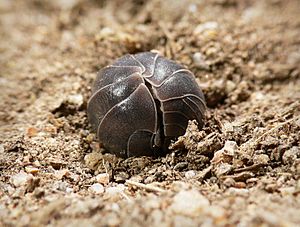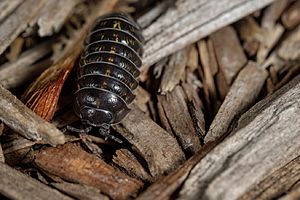Pill bug facts for kids
Quick facts for kids Pill bug |
|
|---|---|
 |
|
| Pill bug | |
 |
|
| Pill bug in its defensive posture | |
| Scientific classification | |
| Kingdom: | |
| Phylum: | |
| Subphylum: | |
| Class: | |
| Order: | |
| Suborder: | |
| Family: |
Armadillidiidae
Brandt, 1833
|
Pill bugs are small creatures that can roll into a tight ball when they feel scared. This special ability gives them their common names like pill bugs, roly polies, and doodle bugs. They are also known by their scientific family name, Armadillidiidae.
Even though they look a bit like insects, pill bugs are actually a type of crustacean. Crustaceans are animals with hard outer shells that protect their bodies. Other crustaceans include crabs, lobsters, and shrimp.
The most well-known type of pill bug is called Armadillidium vulgare. Pill bugs are not originally from the Americas. They were brought there from Europe a long time ago.
Pill bugs often look like small, gray pills. Their bodies have three main parts: a head, a middle section called the thorax, and a tail section called the abdomen. They can be different sizes.
On their head, pill bugs have eyes and a mouth. They also have two sets of antennae, but only one set is easy to see. The thorax holds their legs. Pill bugs do not breathe with lungs like humans do. Instead, they have gills, which means they need to stay in damp places to survive. They also like dark spots, like under rocks, and are most active at night or early morning.
Pill bugs usually live for about two years, but some can live up to five years.
Contents
Pill Bug Behavior and Habitat
Pill bugs in the Armadillidiidae family can roll their bodies into a ball. This action is called conglobation. Other animals like pill millipedes (which are often mistaken for pill bugs), armadillos, and cuckoo wasps can also do this. Pill bugs roll up when they feel vibrations or pressure. This is their main way to protect themselves from animals that want to eat them. Rolling up also helps them save water.
What Do Pill Bugs Eat?
Pill bugs mostly eat dead or rotting plants, like leaves and wood. They can also eat living plants, especially when it's wet. They might munch on leaves, stems, roots, and even fruits.
Sometimes, pill bugs can be a problem for farmers, especially in places with a lot of rain. They can eat many different crops, such as corn, beans, squash, and strawberries. They can cause a lot of damage to strawberry plants. Some pill bugs also eat dead animals or animal waste. They will even eat shed snakeskin or dead bugs if they need to.
Pill Bugs in the Ecosystem
Pill bugs are important helpers in their environment because they are decomposers. This means they help break down dead plants and animals, returning nutrients to the soil.
They can also take in harmful metals like copper, zinc, lead, and cadmium. They store these metals in their bodies, which temporarily cleans the soil. However, when a pill bug dies, these metals go back into the soil. Pill bugs are also a food source for many animals, including birds, toads, spiders, wasps, and centipedes.
Pill Bug Classification
The Armadillidiidae family is different from other woodlouse families in a few ways. Their antennae have two parts, and their tail-like parts (called uropods) have a special shape. Of course, their most famous difference is their ability to roll into a ball!
There are currently 15 known groups (genera) within the Armadillidiidae family:
- Alloschizidium
- Armadillidium
- Ballodillium
- Cristarmadillidium
- Cyphodillidium
- Echinarmadillidium
- Eleoniscus
- Eluma
- Paraschizidium
- Paxodillidium
- Platanosphaera
- Schizidium
- Trichodillidium
- Troglarmadillidium
- Typhlarmadillidium
See also
 In Spanish: Armadilídidos para niños
In Spanish: Armadilídidos para niños


